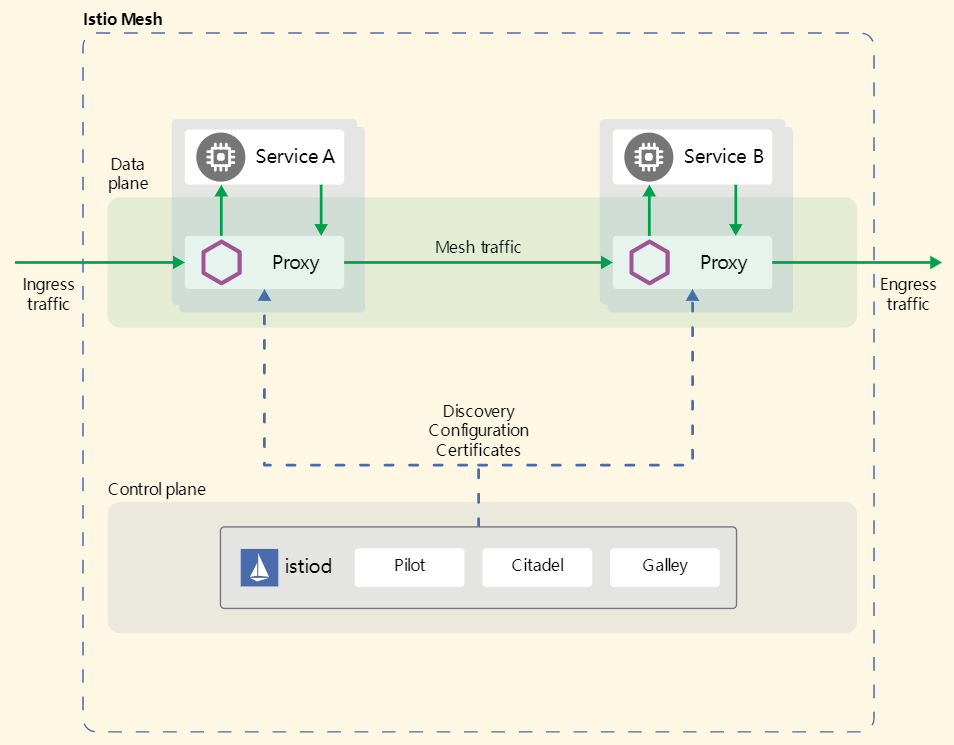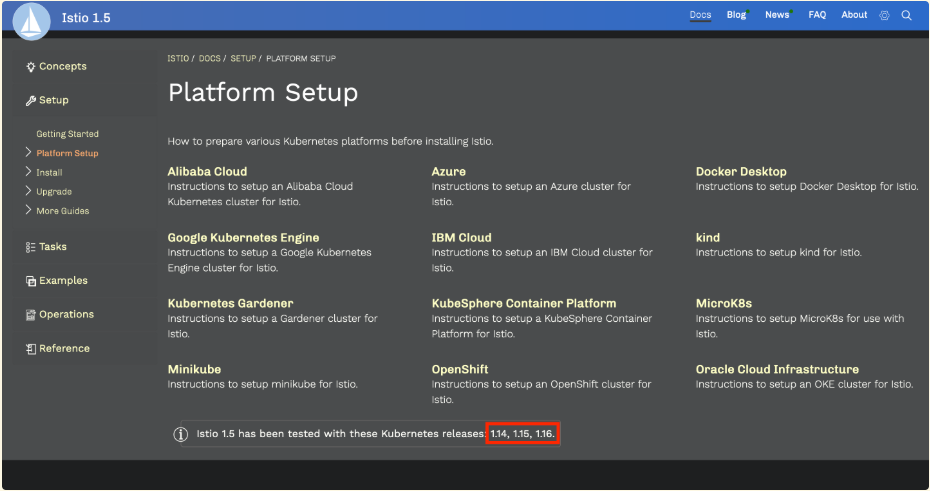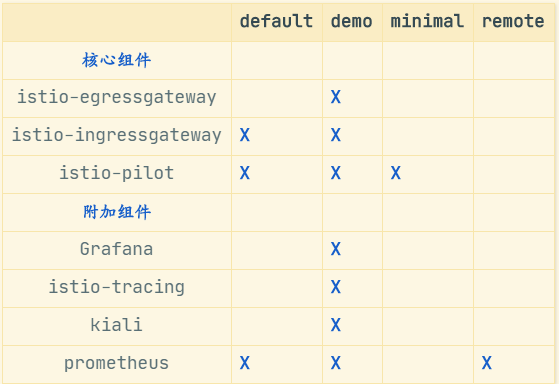Istio 1.5 部署
Sealyun Kubernetes 一键离线安装 。
1.5版本架构图如下:

在 Istio 1.5 中,Mixer 被废弃了,新版本的 HTTP 遥测默认基于 in-proxy Stats filter,同时可使用 WebAssembly 开发 in-proxy 扩展。更详细请参考官网。
为了更方便地管理 Istio 各个组件的生命周期,推荐使用 Operator 进行部署。
在部署 Istio 之前,首先需要确保 Kubernetes 集群(kubernetes 版本建议在 1.14 以上)已部署并配置好本地的 kubectl 客户端。

1. Kubernetes 环境准备
前提条件
下载kubernetes 离线安装包
下载最新版本sealos
务必同步服务器时间
主机名不可重复
安装 kubernetes 集群
sealos init --master 192.168.0.2 \ --node 192.168.0.3 \ --node 192.168.0.4 \ --node 192.168.0.5 \ --user root \ --passwd your-server-password \ --version v1.16.3 \ --pkg-url /root/kube1.16.3.tar.gz
检查安装是否正常:
kubectl get node NAME STATUS ROLES AGE VERSION sealos01 Ready master 18h v1.16.3 sealos02 Ready <none> 18h v1.16.3 sealos03 Ready <none> 18h v1.16.3 sealos04 Ready <none> 18h v1.16.3
2. 下载 Istio 部署文件
你可以从 GitHub 的 release 页面下载 istio,或者直接通过下面的命令下载:
curl -L https://istio.io/downloadIstio | sh -
下载完成后会得到一个 istio-1.5.0 目录,里面包含了:
install/kubernetes : 针对 Kubernetes 平台的安装文件
samples :
bin : istioctl 二进制文件,可以用来手动注入 sidecar proxy
进入 istio-1.5.0 目录。
cd istio-1.5.0 tree -L 1 ./ ./ ├── bin ├── install ├── LICENSE ├── manifest.yaml ├── README.md ├── samples └── tools
4 directories, 4 files
将 istioctl 拷贝到 /usr/local/bin/ 中:
cp bin/istioctl /usr/local/bin/
将 tools 目录中的 istioctl.bash 拷贝到 $HOME 目录中:
cp tools/istioctl.bash ~/
在 ~/.bashrc 中添加一行:
source ~/istioctl.bash
应用生效:
source ~/.bashrc
将 tools 目录中的 _istioctl 拷贝到 $HOME 目录中:
cp tools/_istioctl ~/
在 ~/.zshrc 中添加一行:
source ~/_istioctl
应用生效:
source ~/.zshrc
3. 部署 Istio
istioctl 提供了多种安装配置文件,可以通过下面的命令查看:
ll install/kubernetes/operator/profiles -rw-r--r-- 1 root root 18K 3月 4 20:40 default.yaml -rw-r--r-- 1 root root 3.2K 3月 4 20:40 demo.yaml -rw-r--r-- 1 root root 964 3月 4 20:40 empty.yaml -rw-r--r-- 1 root root 913 3月 4 20:40 minimal.yaml -rw-r--r-- 1 root root 579 3月 4 20:40 remote.yaml -rw-r--r-- 1 root root 554 3月 4 20:40 separate.yaml
差异如下:

标记为X表示该安装该组件。
如果只是想快速试用并体验完整的功能,可以直接使用配置文件 demo 来部署。
在正式部署之前,需要先说明两点:
Istio CNI Plugin
当前实现将用户 pod 流量转发到 proxy 的默认方式是使用 privileged 权限的 istio-init 这个 init container 来做的(运行脚本写入 iptables),需要用到 NET_ADMIN capabilities。对 linux capabilities 不了解的同学可以参考我的 Linux capabilities 系列。
Istio CNI 插件的主要设计目标是消除这个 privileged 权限的 init container,换成利用 Kubernetes CNI 机制来实现相同功能的替代方案。具体的原理就是在 Kubernetes CNI 插件链末尾加上 Istio 的处理逻辑,在创建和销毁 pod 的这些 hook 点来针对 istio 的 pod 做网络配置:写入 iptables,让该 pod 所在的 network namespace 的网络流量转发到 proxy 进程。
详细内容请参考官方文档。
使用 Istio CNI 插件来创建 sidecar iptables 规则肯定是未来的主流方式,不如我们现在就尝试使用这种方法。
Kubernetes 关键插件(Critical Add-On Pods)
众所周知,Kubernetes 的核心组件都运行在 master 节点上,然而还有一些附加组件对整个集群来说也很关键,例如 DNS 和 metrics-server,这些被称为关键插件。一旦关键插件无法正常工作,整个集群就有可能会无法正常工作,所以 Kubernetes 通过优先级(PriorityClass)来保证关键插件的正常调度和运行。要想让某个应用变成 Kubernetes 的关键插件,只需要其 priorityClassName 设为 system-cluster-critical 或 system-node-critical,其中 system-node-critical 优先级最高。
注意:关键插件只能运行在 kube-system namespace 中!
接下来正式安装 Istio,首先部署 Istio operator:
istioctl operator init
该命令会创建一个 namespace istio-operator,并将 Istio operator 部署在此 namespace 中。
kubectl -n istio-operator get pod
NAME READY STATUS RESTARTS AGE
istio-operator-7c69599466-bz8lp 1/1 Running 0 3h29m
然后创建一个 CR IstioOperator:
kubectl create ns istio-system 🐳 → kubectl apply -f - <<EOF apiVersion: install.istio.io/v1alpha1 kind: IstioOperator metadata: namespace: istio-system name: example-istiocontrolplane spec: profile: demo components: cni: enabled: true namespace: kube-system ingressGateways: - enabled: true k8s: service: type: ClusterIP strategy: rollingUpdate: maxUnavailable: 100% maxSurge: 0% nodeSelector: kubernetes.io/hostname: sealos02 overlays: - apiVersion: apps/v1 kind: Deployment name: istio-ingressgateway patches: - path: spec.template.spec value: hostNetwork: true dnsPolicy: ClusterFirstWithHostNet - apiVersion: v1 kind: Service name: istio-ingressgateway patches: - path: spec.ports value: - name: status-port port: 15020 targetPort: 15020 - name: http2 port: 80 targetPort: 80 - name: https port: 443 targetPort: 443 values: cni: excludeNamespaces: - istio-system - kube-system - monitoring logLevel: info EOF
其中各个字段的详细含义请参考 IstioOperator API 文档,这里我简要说明一下:
istio-ingressgateway 的 Service 默认类型为 LoadBalancer,需将其改为 ClusterIP。
为防止集群资源紧张,更新配置后无法创建新的 Pod,需将滚动更新策略改为先删除旧的,再创建新的。
将 istio-ingressgateway 调度到指定节点。
默认情况下除了 istio-system namespace 之外,istio cni 插件会监视其他所有 namespace 中的 Pod,然而这并不能满足我们的需求,更严谨的做法是让 istio CNI 插件至少忽略 kube-system、istio-system 这两个 namespace,如果你还有其他的特殊的 namespace,也应该加上,例如 monitoring。
下面着重解释 overlays 列表中的字段:
HostNetwork
为了暴露 Ingress Gateway,我们可以使用 hostport 暴露端口,并将其调度到某个固定节点。如果你的 CNI 插件不支持 hostport,可以使用 HostNetwork 模式运行,但你会发现无法启动 ingressgateway 的 Pod,因为如果 Pod 设置了 HostNetwork=true,则 dnsPolicy 就会从 ClusterFirst 被强制转换成 Default。而 Ingress Gateway 启动过程中需要通过 DNS 域名连接 pilot 等其他组件,所以无法启动。
我们可以通过强制将 dnsPolicy 的值设置为 ClusterFirstWithHostNet 来解决这个问题,详情参考:Kubernetes DNS 高阶指南。
当然你可以部署完成之后再修改 Ingress Gateway 的 Deployment,但这种方式还是不太优雅。经过我对 IstioOperator API 文档 的研究,发现了一个更为优雅的方法,那就是直接修改资源对象 IstioOperator 的内容,在 components.ingressGateways 下面加上么一段:
overlays: - apiVersion: apps/v1 kind: Deployment name: istio-ingressgateway patches: - path: spec.template.spec value: hostNetwork: true dnsPolicy: ClusterFirstWithHostNet
IstioOperator 的语法做简单说明:
overlays 列表用来修改对应组件的各个资源对象的 manifest,这里修改的是组件 Ingress Gateway 的 Deployment。
patches 列表里是实际要修改或添加的字段。
只暴露必要端口
对于 Ingress Gateway 来说,只需要暴露 HTTP、HTTPS 和 metrics 端口就够了。方法和上面一样,直接在 components.ingressGateways 的 overlays 列表下面加上这么一段:
- apiVersion: v1 kind: Service name: istio-ingressgateway patches: - path: spec.ports value: - name: status-port port: 15020 targetPort: 15020 - name: http2 port: 80 targetPort: 80 - name: https port: 443 targetPort: 443
部署完成后,查看各组件状态:
kubectl -n istio-system get pod NAME READY STATUS RESTARTS AGE grafana-5cc7f86765-rt549 1/1 Running 0 3h11m istio-egressgateway-57999c5b76-59z8v 1/1 Running 0 3h11m istio-ingressgateway-5b97647565-zjz4k 1/1 Running 0 71m istio-tracing-8584b4d7f9-2jbjp 1/1 Running 0 3h11m istiod-86798869b8-jmk9v 1/1 Running 0 3h11m kiali-76f556db6d-qnsfj 1/1 Running 0 3h11m prometheus-6fd77b7876-c4vzn 2/2 Running 0 3h11m kubectl -n kube-system get pod -l k8s-app=istio-cni-node NAME READY STATUS RESTARTS AGE istio-cni-node-4dlfb 2/2 Running 0 3h12m istio-cni-node-4s9s7 2/2 Running 0 3h12m istio-cni-node-8g22x 2/2 Running 0 3h12m istio-cni-node-x2drr 2/2 Running 0 3h12m
可以看到 cni 插件已经安装成功,查看配置是否已经追加到 CNI 插件链的末尾:
cat /etc/cni/net.d/10-calico.conflist
{
"name": "k8s-pod-network",
"cniVersion": "0.3.1",
"plugins": [
...
{
"cniVersion": "0.3.1",
"name": "istio-cni",
"type": "istio-cni",
"log_level": "info",
"kubernetes": {
"kubeconfig": "/etc/cni/net.d/ZZZ-istio-cni-kubeconfig",
"cni_bin_dir": "/opt/cni/bin",
"exclude_namespaces": [
"istio-system",
"kube-system",
"monitoring"
]
}
}
]
}
4. 暴露 Dashboard
通过 Ingress Controller 暴露就好了,可以参考我以前写的 Istio 1.0 部署。
使用 Contour 接管 Kubernetes 的南北流量。
istioctl 提供了一个子命令来从本地打开各种 Dashboard:
istioctl dashboard --help Access to Istio web UIs Usage: istioctl dashboard [flags] istioctl dashboard [command] Aliases: dashboard, dash, d Available Commands: controlz Open ControlZ web UI envoy Open Envoy admin web UI grafana Open Grafana web UI jaeger Open Jaeger web UI kiali Open Kiali web UI prometheus Open Prometheus web UI zipkin Open Zipkin web UI
例如,要想在本地打开 Grafana 页面,只需执行下面的命令:
istioctl dashboard grafana
http://localhost:36813

